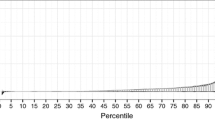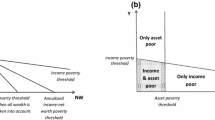Abstract
We analyze the level and distribution of economic well-being in the United States during the 1980s and 1990s based on the standard measure of money income and a measure in which income from wealth is calculated as the sum of lifetime annuity from nonhome wealth and imputed rental-equivalent for owner-occupied homes. Over the 1982–2000 period, median well-being increases faster when these adjustments are made than when standard money income is used. This adjustment also widens the income gap between African-Americans and whites but increases the relative well-being of the elderly. Adding imputed rent and annuities from household wealth to household income considerably increases measured inequality and the share of income from wealth in inequality. However, both measures show about the same rise in inequality over the period. We also find an increasing share of wage and salary income in our expanded definition of income among the richest 1% over the period but do not find that the “working rich” have largely replaced rentiers at the top of the economic ladder.
Similar content being viewed by others
References
Blau, F.D., Graham, J.W.: Black–white differences in wealth and asset composition. Q. J. Econ. 105(2), 321–339 (1990)
Board of Governors of the Federal Reserve System. Federal Reserve Statistical Release, H.15, Selected Interest Rates (2005a) [http://www.federalreserve.gov/releases/h15/]
Board of Governors of the Federal Reserve System. Federal Reserve Statistical Release, Z.1, Flow of Funds Accounts of the United States (2005b). [http://www.federalreserve.gov/Releases/z1/Current/data.htm]
Campbell, A., Converse, P.E., et al.: The Quality of American Life: Perceptions, Evaluations and Satisfactions. Russell Sage Foundation, New York (1976)
Canberra Group. Expert Group on Household Income Statistics: Final Report and Recommendations. Ottawa (2001)
Caner, A., Wolff, E.N.: Asset poverty in the United States, 1984–99: evidence from the panel study of income dynamics. Rev. Income Wealth. 50(4), 493–518 (2004)
Citro, C.F., Michael, R.T. (eds.): Measuring Poverty: A New Approach. National Academy Press, Washington, D.C. (1995)
Council of Economic Advisers. Economic Report of the President. February 2005.
DeNavas-Walt, C., Cleveland, R., Webster Jr., B.H.: U.S. Census Bureau, Current Population Reports, P60–221, Income in the United States: 2002. U.S. Government Printing Office, Washington, D.C. (2003)
Gittleman, M., Wolff, E.N.: Racial differences in patterns of wealth accumulation. J. Hum. Resour. 39(1), 193–227 (2004)
Henderson, H., Lickerman, J., et al., (eds.): Calvert–Henderson quality of life indicators. Calvert Group, Bethesda, MD (2000).
Lerman, D.L., Mikesell, J.J.: Impacts of adding net worth to the poverty definition. East. Econ. J. XIV, (4), 357–70 (1988)
Lerman, R.I., Yitzhaki, S.: Income inequality effects by income source: a new approach and applications to the United States. Rev. Econ. Stat. 67(1), 151–156 (1985)
Lerman, R.I., Yitzhaki, S.: Changing ranks and the inequality impacts of taxes and transfers. Natl. Tax J. XLVIII, (1), 45–59 (1995)
Liu, B.-C.: Quality of Life Indicators in U.S. Metropolitan Areas. Praeger, New York (1976)
Menchik, P.L., Jianakoplos, N.A.: Black–white wealth inequality: is inheritance the reason? Econ. Inq. XXXV, 428–442 (1997) April
Moon, M.: The Measurement of Economic Welfare: Applications to the Aged. Academic Press, New York (1977)
Oliver, M.L., Shapiro, T.M.: Black Wealth/White Wealth: A New Perspective on Racial Inequality. Routledge, New York and London (1995)
Osberg, L., Sharpe, A.: An index of economic well-being for selected OECD countries. Rev. Income Wealth. 48(3), 291–316 (2002)
Radner, D.B., Vaughan, D.R.: Wealth, income, and the economic status of aged households. In: Wolff, E.N. (ed.) International Comparisons of the Distribution of Household Wealth, pp. 93–120. Oxford University Press, New York (1987)
Piketty, T., Saez, E.: Income inequality in the United States, 1913–1998. Q. J. Econ. 118(1), 1–39 (2003)
Piketty, T., Saez, E:. Income inequality in the United States, 1913–1998. NBER Working Paper No.8467 (2001).
Sen, A.: Cooperation, inequality and the family. Popul. Dev. Rev. 15, (Supplement on Rural Development and Population: Institutions and Policy), 61–76 (1989)
Smeeding, T.M., Weinberg, D.H.: Toward a uniform definition of household income. Rev. Income Wealth. 47(1), 1–24 (2001)
Taussig, M.K.: Alternative measures of the distribution of economic welfare. Princeton University Industrial Relations Section Monograph. (1973)
Weisbrod, B.A., Hansen, W.L.: An income-net worth approach to measuring economic welfare. Am. Econ. Rev. 58(5), 1315–1329 (1968)
Wolff, E.N.: Wealth holdings and poverty status in the U.S. Rev. Income Wealth, Series. 36(2), 143–165 (1990)
Wolff, E.N.: The devolution of the American pension system: who gained and who lost? East Econ. J. 29(4), 477–495 (2003)
Wolff, E.N.: Changes in household wealth in the 1980s and 1990s in the U.S.. International perspectives on household wealth. In: Wolff, E.N. (ed.) pp. 107–150. Elgar Publishing Ltd., Cheltenham, U.K. (2006)
Wolff, E.N.: The retirement wealth of the baby boom generation. J. Monet. Econ. 54(1), 1–40 (2007)
Wolff, E.N., Zacharias, A., Caner, A.: Levy Institute Measure of Economic Well-being, Concept, Measurement, and Findings: United States, 1989 and 2000. The Levy Economics Institute, Annandale-on-Hudson, N.Y (2004) February
Wolff, E.N., Zacharias, A.: The Levy institute measure of economic well-being. Indicators: A Journal of Social Health. 2(4), 44–73 (2003)
Wolfson, M.C.: Wealth and the distribution of income, Canada, 1969–1970. Rev. Income Wealth. 25(2), 129–140 (1979)
Author information
Authors and Affiliations
Corresponding author
Rights and permissions
About this article
Cite this article
Wolff, E.N., Zacharias, A. Household wealth and the measurement of economic well-being in the United States. J Econ Inequal 7, 83–115 (2009). https://doi.org/10.1007/s10888-007-9068-6
Received:
Accepted:
Published:
Issue Date:
DOI: https://doi.org/10.1007/s10888-007-9068-6




